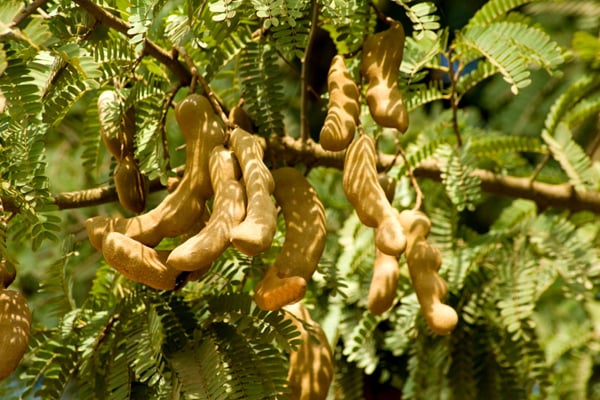Harvesting tamarind for sweet returns

Tamarind fruits hanging from the tree. Photo / Net
What you need to know:
- Tamarind is a versatile and multipurpose tropical tree used as a fruit, seed and fuel wood. Tamarind is used as food additives but there is low production, processing, value addition and by-product development.
Tamarind is an indigenous fruit tree of the tropics with great potential yet underutilised worldwide.
Originally from India, tamarind is widespread throughout tropical dry Africa and tropical Asia, giving the impression that it is a domestic species from the driest savannahs of tropical Africa.
Tamarind grows into a large evergreen tree approximately 20–30m tall. The tree possesses great potential to address various nutritional, health, socio-economic and environmental constraints.
It is believed to be indigenous in Uganda in the districts of Butaleja, Tororo, Teso region, Acholi and Lango sub-regions and the West Nile region.
Tamarind has traditionally served as supplement to communities’ food needs, especially during times of scarcity. Communities in these regions have been conserving the tree over a long period of time.
There is not so much expert involvement in Tamarind farming in Uganda apart from the head and associate professor in the Department of Forestry, Biodiversity and Tourism, Makerere University, Prof Phillip Nyeko, with a team of scientists, who have taken the initiative to carry out research detailing the plant in Uganda.
Uses
The scientists in a publication about “Knowledge, attitudes and practices in tamarind use and conservation in Eastern Uganda”, explain that tamarind fruit is mainly used for juice, porridge and ugali.
The seed pulp is compact and contains some fibrous threads and it has both sweet and sour taste.
The fruit pulp is rich in sour acid and is used as a preservative in the fruit and vegetable industry.
The green hard pulp of immature fruits is too sour to be consumed directly but is often used for cooking tasty dishes. Its ripe fruits are edible and popular because they are sweeter but still very acidic. They are used in desserts in the form of jam, pressed to make juices or sugary drinks.
They are also used as a natural purge and some people consume the fruit directly. They are used as ferments of cereal porridge.
Agronomy
Prof Nyeko says the tree grows by self-propagation. The tree usually fruits within 3-4 years if provided optimum growing conditions.
Young trees should be planted in large holes to accommodate the root system
Some communities mainly in West Africa are practising grafting and raising seedlings in pots before transferring for planting in the field.
Tamarind is very sensitive to cold conditions. The optimum rainfall requirement is 750-1900mm but can thrive in region with low annual rainfall of 500-750mm.
It can thrive in a variety of soils, but deep loamy soils providing optimum condition for development of its long tap roots are ideal. It can tolerate slightly saline and alkaline soils.
Varieties
The experts explain that there are very few well recognised tamarind varieties. However, in the recent past, seedling selections have been identified on the basis of fruit quality and yield.
The most common grown in Africa is Tamarindus indica L: Leguminosae.
Other known varieties are Kibwezi accessions from Kenya and Nazino from Burkina Faso, which have large size fruits.
Planting
In order to provide space and proper medium for development of vigorous and deep tap root system, planting should be done in pits of 1x1m size.
The pits should be dug before the onset of rains and filled in with 2kg single superphosphate at the base and with a mixture of well decomposed farm yard manure and top soil.
The planting distance may vary from 8x8m to 10mx10m depending on the soil type. Closer spacing in shallow soils and wider spacing in deep soils should be adopted.
Spacing varies according to climatic conditions and selected tamarind accessions and farmers can use about 100 tree seedlings per hectare.
Management
Operations such as weeding must be carried out regularly. Cover crops like cowpea, green gram and bush beans may be grown during rainy season to control weeds and soil erosion must be checked in a bid to improve soil health.
Low growing vegetables can be grown during initial 4-5 years to get early returns.
Farmers must ensure young plants are supported with bamboo sticks and irrigation done during the dry season for up to 3-4 years of planting.
There are hardly any pests and diseases that attack tamarind plant though no scientific studies have been done to identify such challenges.
Harvesting
Seed propagated plants start bearing fruits from 7-8 years after planting. While grafted or budded plants will start fruiting 4-5 years of planting. A well-managed tree will yield 300-500kg of ripe pods.
Tamarind fruits ripen during the dry season. Harvesting is mostly done by climbing and shaking the tree so that the fruits fall to the ground.
Alternatively a long stick is used to remove the fruits. However, fruits for sale are picked directly from trees to avoid contamination with soil as buyers would not accept visibly contaminated fruit.
Alternatively, the higher branches are accessed using a ladder.
However, at points of sale such as markets, men are involved in processing of tamarind which included removing the shell to expose the fruit pulp, packing several fruits in transparent polythene and displaying for sale.
Post-harvest handling
After harvesting farmers are expected to spread the pods on ground for 6-7 days.
The shell and seeds as well as the fibrous material is removed and the pulp is collected and stored for a period of 6-12 months in a dry container.
In Uganda, communities harvest and sell the pulp in local markets within their vicinity.
Key facts
Tamarind, known as enkooge in some dialects in Uganda and prized for its sweet-and-sour taste, is rich in vitamins, minerals and antioxidants. Often used to make juice, its sticky pulp is also a rich source of dietary fibre.




